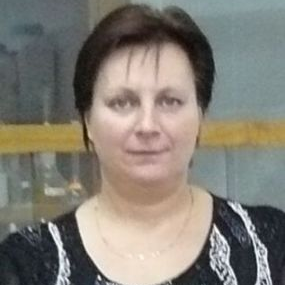Preprint
Article
Hydrogen and Oxygen Evolution on Flexible Catalysts Based on Nickel-Iron Coatings
Altmetrics
Downloads
29
Views
40
Comments
0
A peer-reviewed article of this preprint also exists.
Submitted:
06 November 2024
Posted:
07 November 2024
You are already at the latest version
Alerts
Abstract
Electrolysis of water is one of low-cost green hydrogen production technologies. The challenge is designing and developing low-cost and high-activity catalysts. Herein, we present a strategy to fabricate flexible electrocatalysts based on nickel-iron (NiFe) alloy coatings. NiFe coatings were plated on the flexible copper-coated polyimide surface (Cu/PI) using the low-cost and straightforward electroless metal plating method and morpholine borane as a reducing agent. It was found that Ni90Fe10, Ni80Fe20, Ni60Fe40, and Ni30Fe70 coatings were deposited on the Cu/PI surface, then the concentration of Fe2+ in the plating solution was 0.5 mM, 1 mM, 5 mM, and 10 mM, respectively. Morphology, structure, and composition of NixFey/Cu/PI catalysts have been examined using scanning electron microscopy (SEM), energy dispersive X-ray spectroscopy (EDX), X-ray diffraction (XRD), and inductively coupled plasma optical emission spectroscopy (ICP-OES), whereas their activity has been investigated for hydrogen evolution (HER) and oxygen evolution (OER) reactions in 1 M KOH using linear sweep voltammetry (LSVs). It was found that the Ni80Fe20/Cu/PI catalyst exhibited the lowest overpotential value of –202.7 mV for the HER to obtain a current density of 10 mA cm–2 compared to Ni90Fe10/Cu/PI (–211.9 mV), Ni60Fe40/Cu/PI (–276.3 mV), Ni30Fe70/Cu/PI (–278.4 mV), and Ni (−303.4 mV). On the other hand, the lowest OER overpotential (344.7 mV) was observed for the Ni60Fe40/Cu/PI catalyst to obtain a current density of 10 mA cm–2 as compared with the Ni30Fe70 (369.9 mV), Ni80Fe20 (450.2 mV), Ni90Fe10 (454.2 mV) coatings, and Ni (532.1 mV). The developed Ni60Fe40/Cu/PI catalyst exhibit a cell potential of 1.85 V at 10 mA cm−2. The obtained catalysts seem to be suitable flexible catalysts for HER and OER in alkaline media.
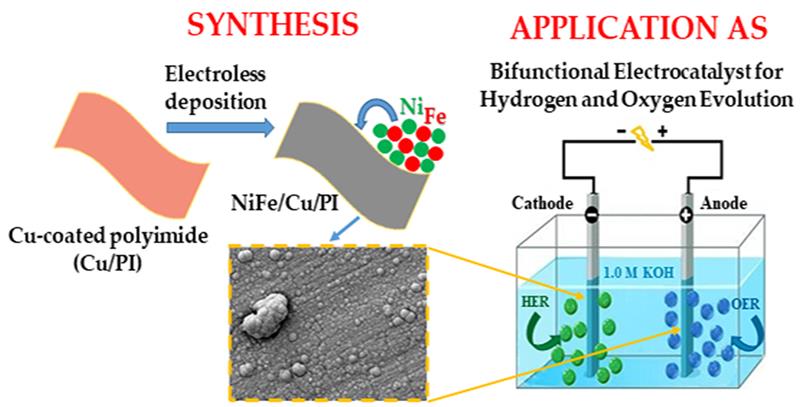
Keywords:
Subject: Chemistry and Materials Science - Electrochemistry
1. Introduction
The search for novel and optimized energy storage and usage technologies is accelerating rapidly. In order to be considered for implementation, these technologies must satisfy three principal criteria: they must be efficient, reliable and inexpensive. Among these technologies, electrochemical energy is emerging as a clear front-runner, offering significant potential for advancement. The production of clean hydrogen via electrolytic water splitting represents a viable and efficient approach, with hydrogen being considered an optimal substitute for traditional fossil fuels [1,2,3]. The electrochemical water splitting process involves two half-reactions: the hydrogen evolution reaction (HER), which occurs at the cathode, and the oxygen evolution reaction (OER), which occurs at the anode electrode. The slow kinetics of these reactions represents a significant challenge that must be addressed. The efficiency of this process can be markedly enhanced through the strategic use of carefully selected catalysts [4]. Advancements in electrocatalysts, in particular those with reduced overpotential and enhanced durability, have the potential to contribute to an improvement in the efficiency of HER/OER processes. Precious metal-based materials, such as Pt for HER and Ir/RuOx or their alloys for OER, have been identified as the most effective catalysts for water splitting. However, there are still some challenges to be addressed, particularly in terms of cost and availability, which could affect their large-scale applications.
A variety of non-noble transition metal-based (TM) catalysts has been developed as an alternative to the high-cost but effective noble metal-based catalysts [5,6,7]. Systems, based on iron and nickel, have been demonstrated to have considerable potential for the overall splitting of water. For example, heterostructures of Fe-Ni3S2/Ni2P [8], Fe-doped nickel-based phosphides [9], Ni/NiFe-Pyro@IF [10], amorphous Ni-Fe-P alloys with varying phosphorous concentrations [11] have demonstrated impressive electrocatalytic activity with respect to both OER and HER processes. However, the intrinsic electrocatalytic effectiveness of the majority of current catalysts has yet to be fully realised, primarily due to a number of challenges, including low activity, low conductivity, poor stability and high aggregation. The electrochemical performance of Ni-Fe catalysts has been enhanced on numerous occasions through the utilisation of non-metallic elements, including sulfur [12], phosphorus [12], boron [13], and selenium [14], among others. The incorporation of additional heteroatoms with varying atomic radii and electronegativities into the catalyst can lead to further changes in the electronic structure of the material surface, thereby speeding the overall water splitting process [11].
In many cases, the selection of an appropriate substrate represents a key strategy for enhancing catalyst performance. For example, the use of high-conductive nickel [15,16] iron [10] or both nickel-iron [12,17] foams not only improve the conductivity of the material, but also significantly increases the electrochemical active surface area of the catalyst. Furthermore, cost-effective carbon-based substrates, including carbon cloth [18,19], carbon nanotubes [19], carbon nitrides [20], graphitic carbon [21], and graphite felt [22], can also be employed for this purpose. However, the use of unmodified pristine carbonaceous materials has been observed to result in reduced activity, particularly at the anodic reaction, due to their susceptibility to oxidative degradation at higher anodic polarisations. In such circumstances, polyimide (PI), which represents a class of conducting polymers, emerges as a potentially more suitable candidate for the substrate due to its favorable electronic conductivity, excellent oxidative stability in both strong acids and alkalis, flexibility, and low cost [23]. Recently, the polyimide-carbon nanotube (PI-CNT) film has been referenced as a promising substrate for a flower-like Co-Ni alloy catalyst, which has demonstrated a notable enhancement in the catalyst’s OER performance. This was characterised by a low overpotential and a rapidly increasing current density [24]. Another high-performing OER catalyst was developed by immobilizing iridium (Ir) single atoms on a PI support, exhibiting high mass activity on a carbon paper electrode while simultaneously achieving outstanding stability with negligible decay for 360 hours [25]. Furthermore, a reduced graphene oxide-polyimide/carbon nanotube film decorated with NiSe nanoparticles was used directly as a HER electrocatalyst without further treatments, which exhibited well-defined HER catalytic activity [26]. Meanwhile, FeNi3/Fe3O4 hybrid NPs anchored to laser-induced graphene (LIG) electrodes directly patterned on both sides of an inexpensive polyimide film showed exceptional performance in water splitting [27].
It is important to note that the use of TM-based catalysts in devices is only possible with the use of polymeric binders such as Nafion. This presents a significant limitation for commercial applications, as it increases electrical resistance, decreases the active area of the catalyst and reduces the efficiency of electrocatalyst binding to the conductive support [28]. Typically, fine-grained catalytic NPs are mixed with a polymer binder (Nafion), conductive fillers and a solvent to form an ink and then sprayed onto the conductive electrodes. However, this frequently results in sparse accumulation or distribution of catalysts. It is therefore of particular importance to consider the use of PI supports for the development of catalysts [23,29]. This work presents a strategy for the fabrication of flexible electrocatalysts based on NiFe alloy coatings on copper-coated low-cost polyimide surfaces (Cu/PI) using a simple, and straightforward electroless metal plating method with the aim of using them as anode/cathode catalysts for hydrogen production by water splitting.
2. Results and Discussion
Production of green hydrogen via water electrolysis is widely investigated and the main research is focused on the search and development of an efficient and low-cost materials with high activity for hydrogen and oxygen evolution reactions. Many materials like Pt-based catalysts, non-noble metal catalysts are created. In this study we present a strategy to fabricate flexible electrocatalysts based on nickel-iron coatings. As flexible substrate we use polyimide coated with a copper film. PI is lightweight, flexible, resistant to heat and chemicals. NixFey coatings were deposited on the Cu surface by a simple electroless metal plating method using morpholine borane (MB) as a reducing agent. The reactions occurring during the NiFe coatings deposition are the oxidation of the reducing agent – MB (Equation (1)) and the cathodic reduction of NiFe (Equation (2)) and boron (B) (Equation (3)):
C4H8ONH·BH3 + 3HOH + OH− → C4H8OH2N+ + B(OH)4− + 5H+ + 6e
C4H8ONH·BH3 + 4HOH + Ni2+ + Fe2+ → NiFe + C4H8OH2N+ + B(OH)4− + 2H2 + 2H+
2C4H8ONH·BH3 + 2H+ → 2BH3 + 2C4H8OH2N+ → 2B + 2C4H8OH2N+ + 3H2
In order to obtain the NiFe coatings with different contents of Ni and Fe, the plating baths were used where concentrations of glycine, nickel sulfate, ethylenediaminetetraacetic acid, and sodium malonate were kept constant, whereas the concentration of iron sulfate ranged from 0.5 mM to 10 mM. The plating bath operated at a temperature of 60 oC for one hour. The composition of the coatings was analyzed by ICP-OES. The data obtained are shown in Table 1. By varying the concentration of iron sulfate in the plating bath, we deposited the NiFe coatings with different compositions – the content of Ni varied from 90 to 30 at.% and iron – from 10 to 70 at.%. As can be seen, when Ni90Fe10, Ni80Fe20, Ni60Fe40, and Ni30Fe70 coatings were deposited on the Cu/PI surface, the concentration of Fe2+ in the plating solution was 0.5 mM, 1 mM, 5 mM, and 10 mM, respectively.
Figure 1 shows the dependence of the deposited Fe and Ni content in the NiFe coatings on the concentration of FeSO4 in the plating solution. It can be seen that by increasing the Fe2+ concentration up to 10 mM, the deposited Ni content decreases and the Fe content increases. In addition, further increases in the Fe2+ concentration in the plating solution result in lower Fe content and higher Ni content in the NiFe coating. The plating rate for the Ni90Fe10, Ni80Fe20, Ni60Fe40, and Ni30Fe70 coatings was approximately 2.6, 3.6, 1.1, and 1.4 mg cm−2 h−1, respectively.
The morphology and composition of the NixFey coatings were characterized using SEM and EDX analysis (Figure 2). From the SEM views, it can be seen that NiFe produces a layer of granular nickel-iron particles up to two hundred nanometers in size (Figure 2a–d). Energy dispersive X-ray analysis confirms the presence of nickel and iron in all coatings (Figure 2a’–d’).
XRD patterns of the NixFey coatings obtained are shown in Figure 3. The peaks at about 43.6°, 50.7° and 74.3° can be respectively indexed to the (111), (200) and (220) planes of the fcc Fe-Ni alloy (JCPDS card No. 47-1405), respectively (Figure 3). For example, in the case of Ni30Fe70, with the higher Fe content, the additional peak at 45.2° is seen in the XRD pattern which can be indexed to the (110) plane of the bcc Fe-Ni alloy (JCPDS card no. 37-0474).
It can be seen that between 10 at.% Fe and 40 at.% Fe (Figure 3a–c), the fcc structure predominates, with the presence of the (111), (200) and (220) fcc peaks. Increasing the Fe content up to 70 at.% in the coating results in the appearance of the bcc (110) contribution, while the fcc (111) remains predominant in the XRD pattern (Figure 3d).
Hydrogen evolution was investigated on the obtained catalysts in an N2-deaerated 1 M KOH solution. The HER polarization curves on the different NixFey/Cu/PI catalysts are shown in Figure 4a.
Data given in Table 2 show that among the investigated catalysts, the lowest onset potential (Eonset) of −0.0928 V exhibits the Ni80Fe20 catalyst compared to the Ni90Fe10, Ni30Fe70, and Ni60Fe40. In addition, this catalyst shows the highest current density at −0.45 V (Figure 4a) and the lowest overpotential of −202.7 mV to achieve the current density of 10 mA cm−2. The reaction kinetics and mechanism of the as-prepared catalysts can be evaluated based on Tafel slopes determined from the following equation (Equation (4)) [30]:
η = b · log j/j0
η is the overpotential, b is the Tafel slope, j is the experimental current density, and j0 is the exchange current density. The plot of η versus log j represents the Tafel slope. It is widely accepted that HER proceeds by either the Volmer–Heyrovsky or Volmer–Tafel mechanisms, and in alkaline media, it involves three main steps as shown in Equations (5)–(7) [31]:
* + H2O + e– ↔ *Hads + OH– (Volmer step)
*Hads + e– + H2O ↔ H2 + OH– + * (Heyrovsky step)
2*Hads ↔ H2 + * (Tafel step)
Hads denotes the H2 adsorbed to the metal sites, where * represents the metal sites. The theoretical Tafel slopes in the aforementioned reaction steps are 120 mV dec−1, 40 mV dec−1, and 30 mV dec−1, respectively. The corresponding Tafel plots for NiFe catalysts are shown in Figure 4b. The calculated Tafel slopes were in the range from ca. 70 to 117 mV dec-1, indicating that HER might occur through the Volmer–Heyrovsky mechanism − which is for water molecules or H2 to adsorb onto an electrode to generate MHads species. The most promising composition of NiFe is Ni 80 at.% and Fe 20 at.% for efficient HER.
The oxygen evolution reaction in an alkaline medium can be represented by Equations (8)–(11) [32,33,34]:
where * denotes the electrocatalyst’s adsorption site, similarly, during OER, the adsorbed intermediates are OH*, O*, and OOH*. The first step of the OER process, denoted by Equation (8), is the electrosorption of OH– onto the active sites of the catalyst’s surface. Higher oxidation state metal species are more susceptible to adsorb OH–, accelerate the multielectron transportation process, and, hence, can therefore enhance the OER process [32,34]. The data of oxygen evolution measurements on the investigated catalysts are shown in Figure 5 and Table 3. As can be seen from the LSVs recorded on Ni and different NixFey catalysts in a 1 M KOH solution, the lower onset and overpotential values at 10 mA cm–2 were obtained on the NixFey catalysts containing a lower content of Ni – 60 and 30 at.% and higher content of iron – 40 and 70 at.% (Figure 5a).
* + OH– ↔ e– + OH*
OH– + OH* ↔ e– + O* + H2O
OH– + O* ↔ e– + OOH*
OH– + OOH* ↔ H2O +*+ e– + O2
The increase of iron content in the NixFey coatings results in a higher activity for oxygen evolution as compared with the coatings containing a lower content of iron and a higher content of nickel. The most promising composition of NiFe is Ni 60 at.% and Fe 40 at.% for efficient OER. The current density of 10 mA cm-2 was reached at this catalyst with an overpotential of 344.7 mV, indicating superior catalytic activity and favorable OER kinetics. The low Tafel slope values of approximately 49.2−69.6 mV dec−1 for NiFe catalysts showed that the oxygen evolution proceeds more easily compared with the pure Ni catalyst (111.2 mV dec−1).
To confirm the bifunctional activity of the developed catalysts for HER and OER in alkaline media, the both cathodic (HER) (Figure 4a) and anodic (OER) (Figure 5a) polarization curves were replotted and are given in Figure 6a.
The potential difference (Δη10) between HER and OER current density of ±10 mA cm−2 (η10OER – η10HER) for NixFey/Cu/PI catalysts represent an expected full-cell potential window. The calculated values of full-cell potential Δη10 delivered from the corresponding HER and OER polarization curves are 1.85 V for Ni60Fe40/Cu/PI, 1.88 V for Ni30Fe70/Cu/PI and Ni80Fe20/Cu/PI, and 1.89 V for Ni90Fe10/Cu/PI (Figure 6a). The obtained values suggest the potential application of catalysts for a practical overall water splitting (OWS) device in an alkaline electrolyte, employing the same electrode materials as both the anode and the cathode. The overall catalytic performance in a two-electrode alkaline electrolyzer cell configuration was also carried out by using the same Ni60Fe40/Cu/PI catalyst as both the anode and the cathode - Ni60Fe40/Cu/PI‖Ni60Fe40/Cu/PI. The developed Ni60Fe40/Cu/PI electrode exhibit a cell potential of 1.85 V at 10 mA cm−2 (Figure 6b) compared to other cell potential values reported in the literature - Ni-Fe/Cu‖Ni-Fe/Cu (1.83 V) [11] and NiO@CNTR‖NiO@CNTR (1.81 V) [35] as well as is comparable with the Pt/C‖IrO2 (1.71 V) and Pt/C‖Pt/C (1.83 V) [36]. The calculated energy efficiency of the Ni60Fe40/Cu/PI cell is 66.5%. Moreover, the turnover frequency (TOF) is important indicator for the determination of the intrinsic activity of the catalysts. Herein, the TOF values were calculated to evaluate the intrinsic OER performance of the prepared NixFey/Cu/PI catalysts at an overpotential of 600 mV. The TOF value of Ni60Fe40/Cu/PI catalyst was observed as 14.9 s–1 at an overpotential of 600 mV, which significantly outperforms that of Ni30Fe70/Cu/PI (9.3 s–1), Ni90Fe10/Cu/PI (1.9 s–1), and Ni80Fe20/Cu/PI (1.8 s–1), indicating high intrinsic properties of this catalyst. The results of our study offer insights into the future design of flexible composite electrocatalysts for sustainable hydrogen production. Furthermore, the suggested strategy allows to produce low-cost, scalable, and self-standing electrocatalysts with efficient water splitting activity and stability.
3. Materials and Methods
3.1. Chemicals
Nickel sulfate (NiSO4·7H2O, >98%, Chempur), iron sulfate heptahydrate (FeSO4·7H2O, 97%, Chempur), morpholine borane (MB, C4H8ONH·BH3, 97%, Alfa Aesar), glycine (NH2CH2COOH, 99%, Chempur), ethylenediaminetetraacetic acid (EDTA, 99%, Reachem), sodium malonate (CH2(COONa)2, 97%, Merck), palladium chloride (PdCl2, 59.5%, Alfa Aesar), copper sulfate pentahydrate (CuSO4·5H2O, 98%, Chempur), sulfuric acid (H2SO4, 98%, Chempur), polyimide (PI) film of 0.125 mm thickness (DuPontTM Kapton® HN, GoodFellow).
3.2. Electroless Plating of NiFe Coatings on Polyimide Coated with Cu Film
Before electroless plating of NiFe coatings, the PI surface was pre-treated by using adhesion/activation pretreatment procedures as described in detail in refs. [37,38]. The Cu layer was electroplated from CuSO4 and H2SO4 solution at a current density of 1 A dm−2 for 45 minutes. Then, the NiFe coatings with different contents of Ni and Fe were deposited on the Cu-coated PI surface using the electroless metal plating and morpholine borane as the reducing agent. Figure 6 shows the scheme of the plating process of NixFey on Cu/PI.
Briefly, the Cu/PI surface was activated with Pd2+ ions by immersion it in a 0.5 g L−1 PdCl2 solution for 30 s, then rinsed with deionized water and placed in a freshly prepared electroless plating solution. The composition of the electroless plating solution and the deposition parameters of the coatings are given in Table 4.
In all cases, the pH of the plating solutions was 7 (measured at room temperature). The plating bath was operated at a temperature of 60 °C for 60 min (Table 4). Concentrations of glycine, nickel sulfate, ethylenediaminetetraacetic acid, and sodium malonate were kept constant, whereas the concentration of iron sulfate was different.
3.3. Characterization of Coatings
The composition of the NiFe coatings deposited on the Cu surface was determined using inductively coupled plasma optical emission spectroscopy (ICP-OES). The Ni and Fe loadings in the coatings were determined using an Optima 7000DV ICP spectrometer (PerkinElmer, Shelton, CT, USA).
The surface morphology of the samples and the distribution of elements were analyzed using a TM4000Plus scanning electron microscope with an AZetecOne detector (Hitachi, Tokyo, Japan).
The XRD patterns of the investigated samples were measured using an X-ray diffractometer D2 PHASER (Bruker, Karlsruhe, Germany). The measurements were performed in the 2θ range of 10–90°.
3.4. Electrochemical Measurements of HER and OER
The performance of the synthesized samples was evaluated using a PGSTAT100 potentiostat/galvanostat (Metrohm Autolab B. V., Utrecht, The Netherlands). A standard three-electrode cell was used, where the working electrode was NiFe/Cu/PI with a geometric surface area of 2 cm2. The reference and counter electrodes were Ag/AgCl (3 M KCl) and glassy carbon (GC), respectively. Linear sweep voltammograms (LSVs) were recorded in an N2-saturated 1 M KOH solution at a scan rate of 2 mV s−1. For comparison, a Ni foam electrode (2 cm2) was used. All reported potential values were referred to the reversible hydrogen electrode (ERHE) according to the following Equation (12):
where EAg/AgCl (3 M KCl) = 0.210 V.
ERHE = Emeasured + 0.059·pH + EAg/AgCl (3 M KCl)
The HER and OER current densities presented in this paper have been scaled to the geometric area of the catalysts.
Two-electrode water electrolysis cell was constructed using two the same Ni60Fe40/Cu/PI electrodes as the anode and the cathode. Energy efficiency of the cell was calculated using the following equation:
where Eth = 1.23 V; Ve at j is the input voltage required to drive the electrolysis at the current density of interest. The energy efficiency calculated in this study was obtained at j = 10 mA cm−2.
ηelectrolyzer = Eth/Ve at j
The turnover frequency (TOF) value was calculated using the following Equation (14) [39]:
where j is the current density at an overpotential of 600 mV, A is the geometric surface area of the electrode, F is the Faraday constant (96,485 C mol–1), 4 is the number of electrons transferred in the OER, and n is the number of moles of all metal ions calculated from the ICP-OES results.
TOF =j × A / 4 × F × n
4. Conclusions
In this study, we highlighted a promising strategy to fabricate cost-effective and flexible catalysts for electrochemical water splitting devices. NiFe coatings containing different contents of Ni and Fe have been plated on the flexible copper-coated polyimide surface using the low-cost and straightforward electroless metal plating method and morpholine borane as a reducing agent. It was found that the most promising catalysts for HER and OER are Ni80Fe20/Cu/PI and Ni60Fe40/Cu/PI catalysts, respectively. The Ni80Fe20/Cu/PI catalyst exhibited the lowest overpotential value of –202.7 mV for the HER to obtain a current density of 10 mA cm–2, while the lowest OER overpotential (344.7 mV) was observed for the Ni60Fe40/Cu/PI catalyst to obtain a current density of 10 mA cm–2. It was found that a cell potential of 1.85 V at 10 mA cm−2 was achieved by employing the developed flexible Ni60Fe40/Cu/PI catalyst as the anode and the cathode (Ni60Fe40/Cu/PI‖Ni60Fe40/Cu/PI). The exploration of the bifunctional electrocatalysts for overall water splitting by NixFey deposited on Cu-coated polyimide provide insights into the future design of composite electrocatalysts for the production of hydrogen via the electrochemical water splitting.
Author Contributions
Conceptualization, L.T.-T. and E.N.; methodology, D.Sh.; validation, Z.S., J.V. and B.S.; formal analysis, A.B., A.N. and Z.S.; investigation, D.Sh., A.B., A.N., B.S. and J.V.; data curation, J.V.; B.S. and A.N.; writing—original draft preparation, L.T.-T. and D.S.; writing—review and editing, E.N. and D.S.; visualization, A.N.; B.S. and A.B.; supervision, L.T.-T.; project administration, L.T.-T.; funding acquisition, L.T.-T. All authors have read and agreed to the published version of the manuscript.
Funding
This research was funded by a grant (No. P-MIP-23-467) from the Research Council of Lithuania.
Institutional Review Board Statement
Not applicable.
Data Availability Statement
Not applicable.
Conflicts of Interest
The authors declare no conflicts of interest.
References
- Gong, Y.; Yao, J.; Wang, P.; Li, Z.; Zhou, H.; Xu, C. Perspective of hydrogen energy and recent progress in electrocatalytic water splitting. Chin. J. Chem. Eng. 2022, 43, 282–296. [Google Scholar] [CrossRef]
- Hota, P.; Das, A.; Maiti, D.K. A short review on generation of green fuel hydrogen through water splitting. Int. J. Hydrogen Energy 2023, 48, 523–541. [Google Scholar] [CrossRef]
- Elsapagh, R.M.; Sultan, N.S.; Mohamed, F.A.; Fahmy, H.M. The role of nanocatalysts in green hydrogen production and water splitting. Int. J. Hydrogen Energy 2024, 67, 62–82. [Google Scholar] [CrossRef]
- Solanki, R.; Patra, I.; Ahmad, N.; Kumar, N.B.; Parra, R.M.R.; Zaidi, M.; Yasin, G.; Kumar, T.Ch.A.; Hussein, H.A.; Sivaraman, R.; Majdi, H.Sh.; Alkadir, O.K.A.; Yaghobi, R. Investigation of recent progress in metal-based materials as catalysts toward electrochemical water splitting. J. Environ. Chem. Eng. 2022, 10, 108207. [Google Scholar] [CrossRef]
- Li, X.-P.; Huang, C.; Han, W.-K.; Ouyang, T.; Liu, Z.-Q. Transition metal-based electrocatalysts for overall water splitting. CCL 2021, 32, 2597–2616. [Google Scholar] [CrossRef]
- Li, Z.; Zhang, X.; Ou, C.; Zhang, Y.; Wang, W.; Dong, S.; Dong, X. Transition metal-based self-supported anode for electrocatalytic water splitting at a large current density. Coord. Chem. Rev. 2023, 495, 215381. [Google Scholar] [CrossRef]
- Li, Y.; Zhou, L.; Guo, S. Noble metal-free electrocatalytic materials for water splitting in alkaline electrolyte. EnergyChem 2021, 3, 100053. [Google Scholar] [CrossRef]
- Wang, X.; Yu, X.; Bai, J.; Yuan, G.; He, P.; Zhu, Y.; Wu, S.; Qin, F.; Ren, L. Interface engineering assisted Fe-Ni3S2/Ni2P heterostructure as a high-performance bifunctional electrocatalyst for OER and HER. Electrochim. Acta 2023, 458, 142524. [Google Scholar] [CrossRef]
- Sun, S.; Zhang, C.; Ran, M.; Zheng, Y.; Li, C.; Jiang, Y.; Yan, X. Fe-doped promotes phosphorization and dispersibility of Ni catalysts for efficient and stable HER and OER. Int. J. Hydrogen Energy 2024, 63, 133–141. [Google Scholar] [CrossRef]
- Liu, Y.; Ma, X.; Huang, H.; Deng, G.; Wang, J.; Chen, X.; Gao, T. Ammonia-assisted Ni particle preferential deposition in Ni-Fe pyrophosphates on iron foam to improve the catalytic performance for overall water splitting. J. Colloid Interf. Sci. 2024, 665, 573–581. [Google Scholar] [CrossRef]
- Xu, W.; Qiu, R.; Mao, X.; Yan, X.; Peng, B.; Shen, Y. One-step fabrication of amorphous Ni-Fe phosphated alloys as efficient bifunctional electrocatalysts for overall water splitting. J. Non-Cryst. Solids 2022, 587, 121598. [Google Scholar] [CrossRef]
- Liu, S.; Wang, Y.; Gao, J.; Jin, W.; Xiao, W.; Xin, L.; Xiao, Z.; Xu, G.; Dai, C.; Zhang, H.; Wu, Z.; Wang, L. Anionic phosphorous and sulfur regulate self-supported Ni-Fe-based electrocatalyst for water-splitting under large current density. Fuel 2024, 367, 131445. [Google Scholar] [CrossRef]
- Han, P.; Tan, T.; Wu, F.; Cai, P.; Cheng, G.; Luo, W. Nickel-iron borate coated nickel-iron boride hybrid for highly stable and active oxygen evolution electrocatalysis. CCL 2020, 31, 2469–2472. [Google Scholar] [CrossRef]
- Dai, Z.; Du, X.; Zhang, X. The synthesis of Ni-Co-Fe-Se@NiCo-LDH nanoarrays on Ni foam as efficient overall water splitting electrocatalyst. J. Alloys Compd. 2023, 946, 169451. [Google Scholar] [CrossRef]
- Shi, Y.; Li, C.; Tu, Y.; Jiang, Y.; Xiao, W.; Zhu, S.; Lv, P.; Yan, X. Surface reconstruction of Fe doping NiC2O4 by the electrocatalytic reaction to improve the performance of overall water splitting. Ceram. Int. 2024, 50, 36340–36348. [Google Scholar] [CrossRef]
- Lu, P.; Zhao, H.; Jiang, X.; Yang, L.; Xie, G.; Xie, T.; Jiang, L. Electroless deposition synthesis of composite catalysts Ni-Fe-P-Ni(OH)2/NF with superior overall water splitting performance. J. Environ. Chem. Eng. 2024, 12, 114039. [Google Scholar] [CrossRef]
- Zeng, L.; Yang, L.; Lu, J.; Jia, J.; Yu, J.; Deng, Y.; Shao, M.; Zhou, W. One-step synthesis of Fe-Ni hydroxide nanosheets derived from bimetallic foam for efficient electrocatalytic oxygen evolution and overall water splitting. CCL 2018, 29, 1875–1878. [Google Scholar] [CrossRef]
- Xiao, M.; Jiao, L.; Xiang, D.; Gao, P.; Fu, J.; Naseri, A.; Huang, S. Synergistic electronic structure tuning of self-assembled hollow hierarchical Ni-Fe-Co-P nanowire arrays on carbon cloth for enhanced water splitting. J. Alloys Compd. 2023, 968, 171883. [Google Scholar] [CrossRef]
- Shao, S.; Li, X.; Guo, R.; Wang, J.; Sheng, M. Ni-Fe-P nanoparticles encapsulated in carbon nanotubes supported on carbon cloth for overall water splitting. Mater. Lett. 2023, 352, 135204. [Google Scholar] [CrossRef]
- Shin, Y.; Cho, S.C.; Park, G.; Seol, J.H.; Lim, D.; Choi, S.; Jo, C.; Baeck, S.H.; Lim, J.; Lee, S. U.; Park, S. Atomic-level insights into bioinspired Fe/Ni bimetallic active sites on carbon nitrides for electrocatalytic O2 evolution. J. Chem. Eng. 2024, 85, 149799. [Google Scholar] [CrossRef]
- Kalusulingam, R.; Ravi, K.; Mathi, S.; Yadhav, N.; Mikheykin, A.S.; Biradar, A.V.; Srinivasan, K.; Myasoedova, T.N. Bimetallic Ni–Fe nanoparticles encapsulated with biomass-derived N-doped graphitic carbon core-shell nanostructures an efficient bifunctional electrocatalyst for enhanced overall seawater splitting and human urine electrolysis. Mater. Today Sustain. 2024, 27, 100864. [Google Scholar] [CrossRef]
- Abdelrahim, A.M.; El-Moghny, M.G.A.; El-Deab, M.S. Interface construction of Ni(OH)2/Fe3O4 heterostructure decorating in-situ defected graphite felt for enhanced overall water splitting. Int. J. Hydrogen Energy 2024, 81, 173–186. [Google Scholar] [CrossRef]
- Kim, T.; Lee, J.; Kim, N.; Lee, S.; Gu, M.; Kim, B.-S. Redox-active polyimides for energy conversion and storage: from synthesis to application. Chem. Com. 2023, 59, 153–169. [Google Scholar] [CrossRef] [PubMed]
- Li, X.; Wang, T.; Wang, C. An advanced flower-like Co-Ni/PI-CNT film electrocatalyst for oxygen evolution reaction. J. Alloys Compd. 2017, 729, 19–26. [Google Scholar] [CrossRef]
- Zhang, L.; Bai, J.; Zhang, S.; Liu, Y.; Ye, J.; Fan, W.; Debroye, E.; Liu, T. Atomically dispersed iridium on polyimide support for acidic oxygen evolution. ACS Nano 2024, 18, 22095–22103. [Google Scholar] [CrossRef]
- Wang, T.; Li, X.; Jiang, Y.; Zhou, Y.; Jia, L.; Wang, C. Reduced graphene oxide-polyimide/carbon nanotube film decorated with NiSe nanoparticles for electrocatalytic hydrogen evolution reactions. Electrochim. Acta 2017, 243, 291–298. [Google Scholar] [CrossRef]
- Xie, Y.; Zhang, C.; He, X.; White, T.; D. Demaree, J.; Griep, M.; Lina, J. Monolithic electrochemical cells for overall water splitting. J. Power Sources 2018, 397, 37–43. [Google Scholar] [CrossRef]
- McGovern, M.S.; Garnett, E.C.; Rice, C.; Masel, R.I. , Wieckowski, A. Effects of Nafion as a binding agent for unsupported nanoparticle catalysts. J. Power Sources 2003, 115, 35–39. [Google Scholar] [CrossRef]
- Liu, H.; Wang, X.; Antwi-Afari, M.F.; Mi, H.-Y.; Liu, C. A state-of-the-art review of polyimide foams research. Constr. Build. Mater. 2024, 437, 136961. [Google Scholar] [CrossRef]
- Zhu, G.X.; Lu, T.L.; Han, L.; Zhan, Y.Z. Graphitic carbon nitride (g–C3N4) as an efficient metal-free Fenton-like catalyst for degrading organic pollutants: The overlooked non-photocatalytic activity. Water Sci. Technol. 2020, 81, 518–528. [Google Scholar] [CrossRef]
- Zahra, R.; Pervaiz, E.; Baig, M.M.; Rabi, O. Three-dimensional hierarchical flowers-like cobalt-nickel sulfide constructed on graphitic carbon nitride: Bifunctional non-noble electrocatalyst for overall water splitting. Electrochim. Acta 2022, 418, 140346. [Google Scholar] [CrossRef]
- Bian, H.; Chen, T.; Chen, Z.; Liu, J.; Li, Z.; Du, P.; Zhou, B.; Zeng, X.; Tang, J.; Liu, C. One-step synthesis of mesoporous cobalt sulfides (CoSx) on the metal substrate as an efficient bifunctional electrode for overall water splitting. Electrochim. Acta 2021, 389, 138786. [Google Scholar] [CrossRef]
- Ejeta, S.Y.; Imae, T. Cobalt incorporated graphitic carbon nitride as a bifunctional catalyst for electrochemical water-splitting reactions in acidic media. Molecules 2022, 27, 6445. [Google Scholar] [CrossRef] [PubMed]
- Trotochaud, L.; Ranney, J.K.; Williams, K.N.; Boettcher, S.W. Solution-cast metal oxide thin film electrocatalysts for oxygen evolution. J. Am. Chem. Soc. 2012, 134, 17253–17261. [Google Scholar] [CrossRef] [PubMed]
- Ganguly, A.; McGlynn, R.J.; Boies, A.; Maguire, P.; Mariotti, D.; Chakrabarti, S. Flexible bifunctional electrode for alkaline water splitting with long-term stability. ACS Appl. Mater. Interf. 2024, 16, 12339–12352. [Google Scholar] [CrossRef] [PubMed]
- Jiao, L.; Zhou, Y.X.; Jiang, H.L. Metal–organic framework-based CoP/reduced graphene oxide: high-performance bifunctional electrocatalyst for overall water splitting. Chem. Sci. 2016, 7, 1690–1695. [Google Scholar] [CrossRef]
- Naruškevičius, L.; Tamašauskaitė-Tamašiūnaitė, L.; Žielienė, A.; Jasulaitienė, V. A Co-based surface activator for electroless copper deposition. Surf. Coat. Technol. 2012, 206, 2967–2971. [Google Scholar] [CrossRef]
- Hyman, M.; Naruškevičius, L.; Budilovskis, D. US10920321B2 (2021-02-16).
- Zhou, T.; Cao, Z.; Zhang, P.; Ma, H.; Gao, Z.; Wang, H.; Lu, Y.; He, J.; Zhao, Y. Transition metal ions regulated oxygen evolution reaction performance of Ni-based hydroxides hierarchical nanoarrays. Scientific Reports 2017, 7, 46154. [Google Scholar] [CrossRef]
Figure 1.
The content of deposited Fe and Ni in NiFe coatings as a function of the concentration of FeSO4 in the plating solution.
Figure 1.
The content of deposited Fe and Ni in NiFe coatings as a function of the concentration of FeSO4 in the plating solution.
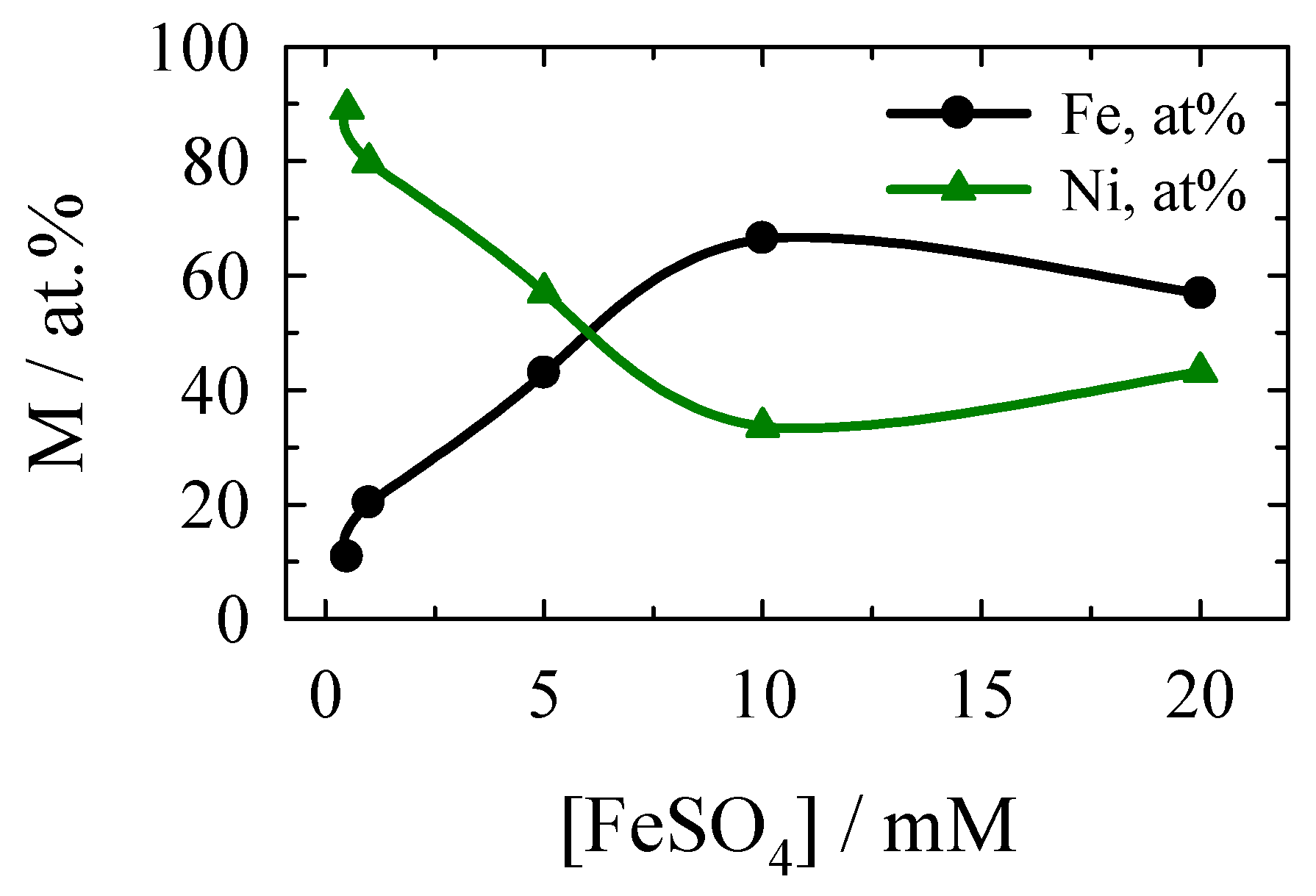
Figure 2.
SEM images of Ni90Fe10 (a), Ni80Fe20 (b), Ni60Fe40 (c), and Ni30Fe70 (d) coatings and the corresponding EDX spectra (a’-d’).
Figure 2.
SEM images of Ni90Fe10 (a), Ni80Fe20 (b), Ni60Fe40 (c), and Ni30Fe70 (d) coatings and the corresponding EDX spectra (a’-d’).
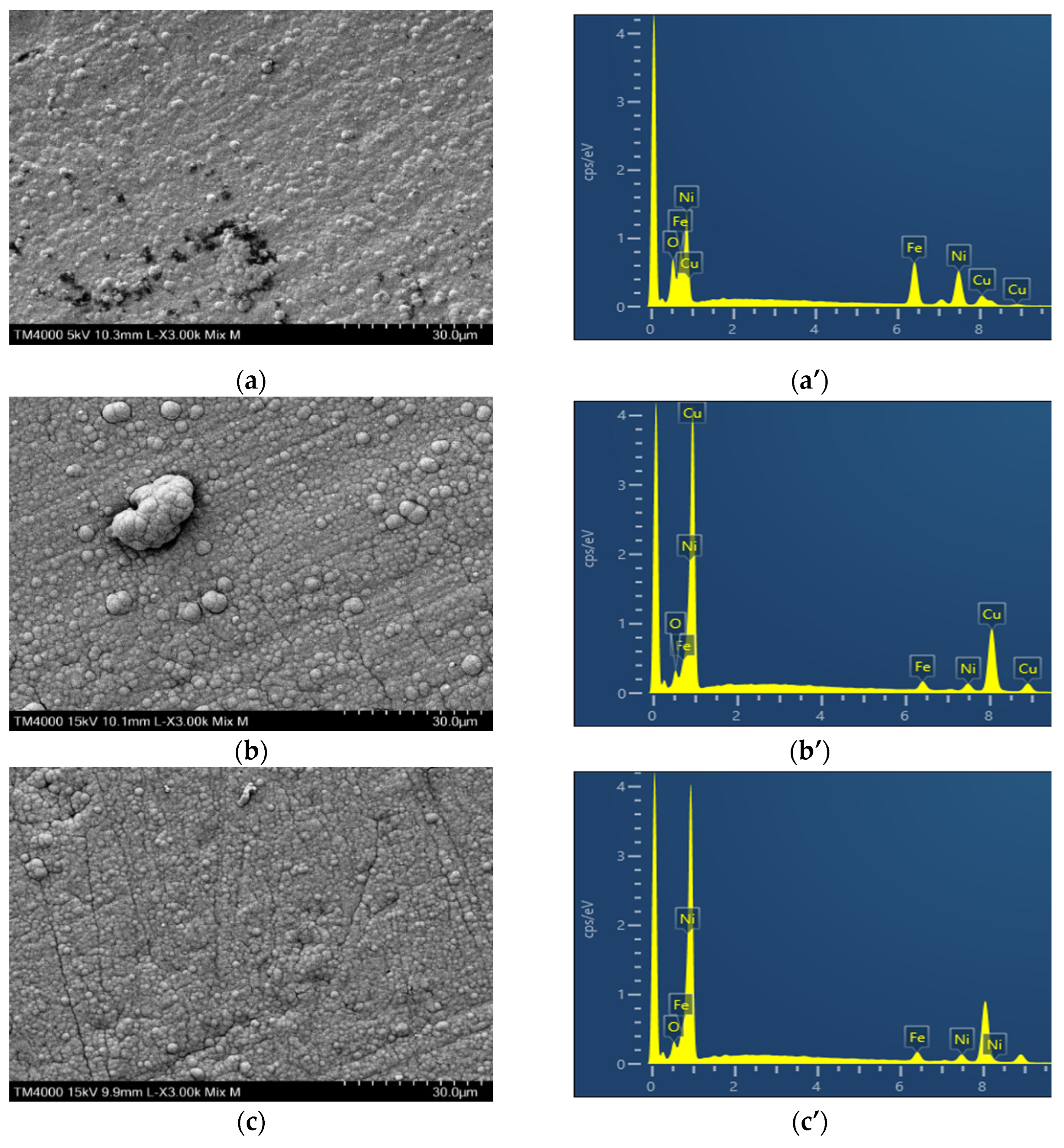
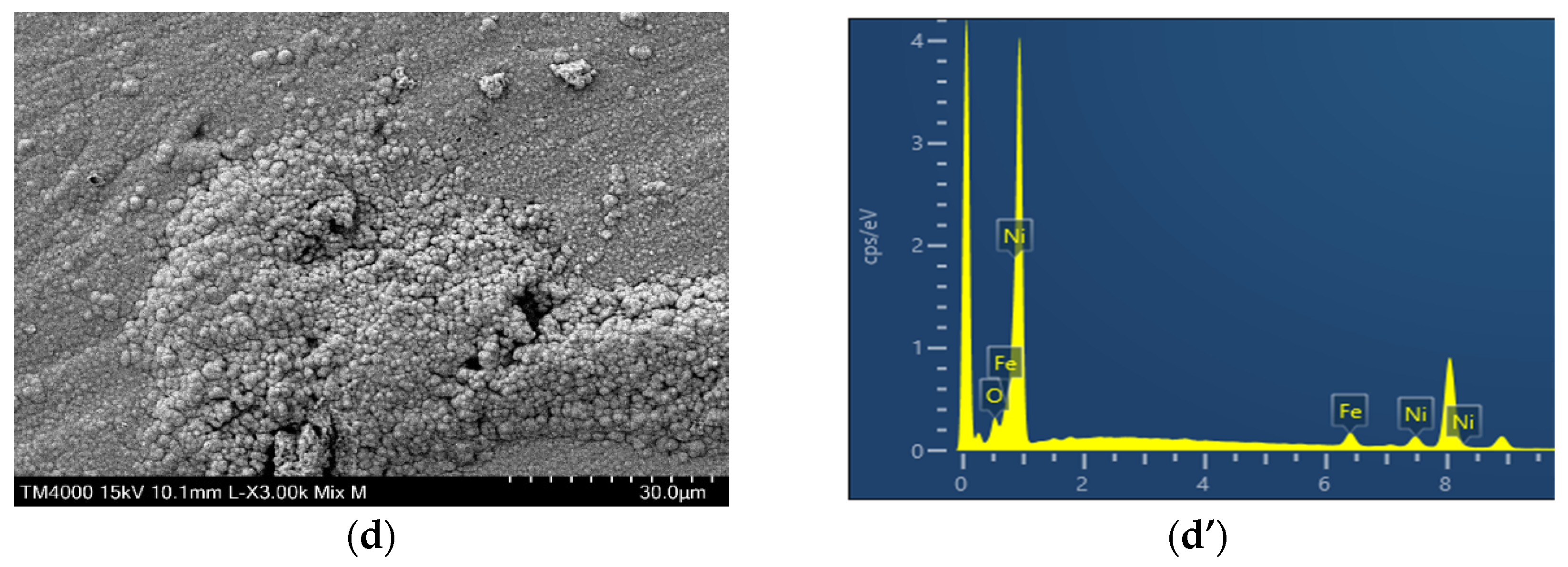
Figure 3.
XRD patterns of different NixFey coatings.
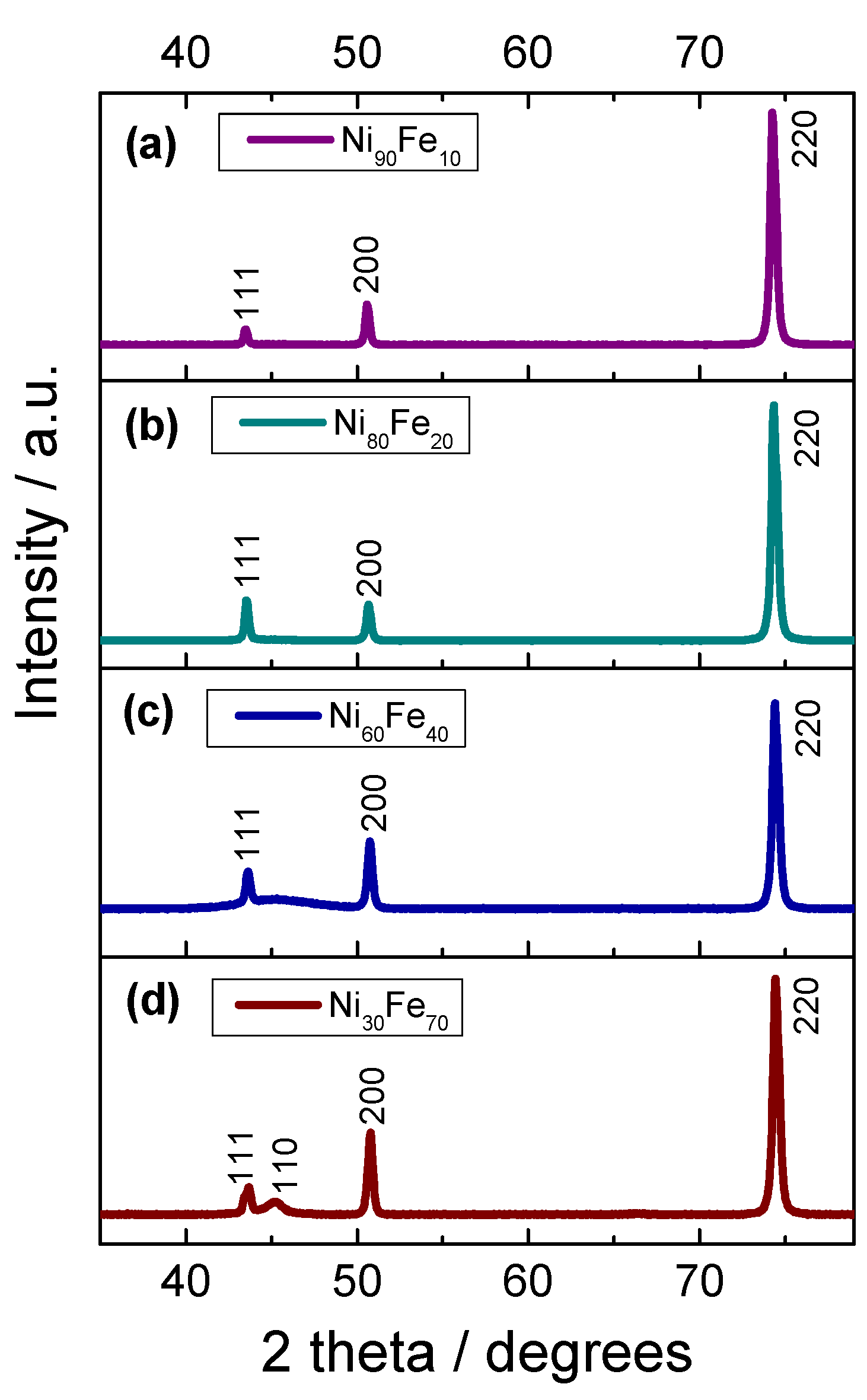
Figure 4.
(a) HER polarization curves of Ni, Ni90Fe10, Ni80Fe20, Ni60Fe40, and Ni30Fe70 catalysts in N2-saturated 1 M KOH solution at a potential scan rate of 2 mV s−1; (b) The corresponding Tafel slopes for each catalyst.
Figure 4.
(a) HER polarization curves of Ni, Ni90Fe10, Ni80Fe20, Ni60Fe40, and Ni30Fe70 catalysts in N2-saturated 1 M KOH solution at a potential scan rate of 2 mV s−1; (b) The corresponding Tafel slopes for each catalyst.
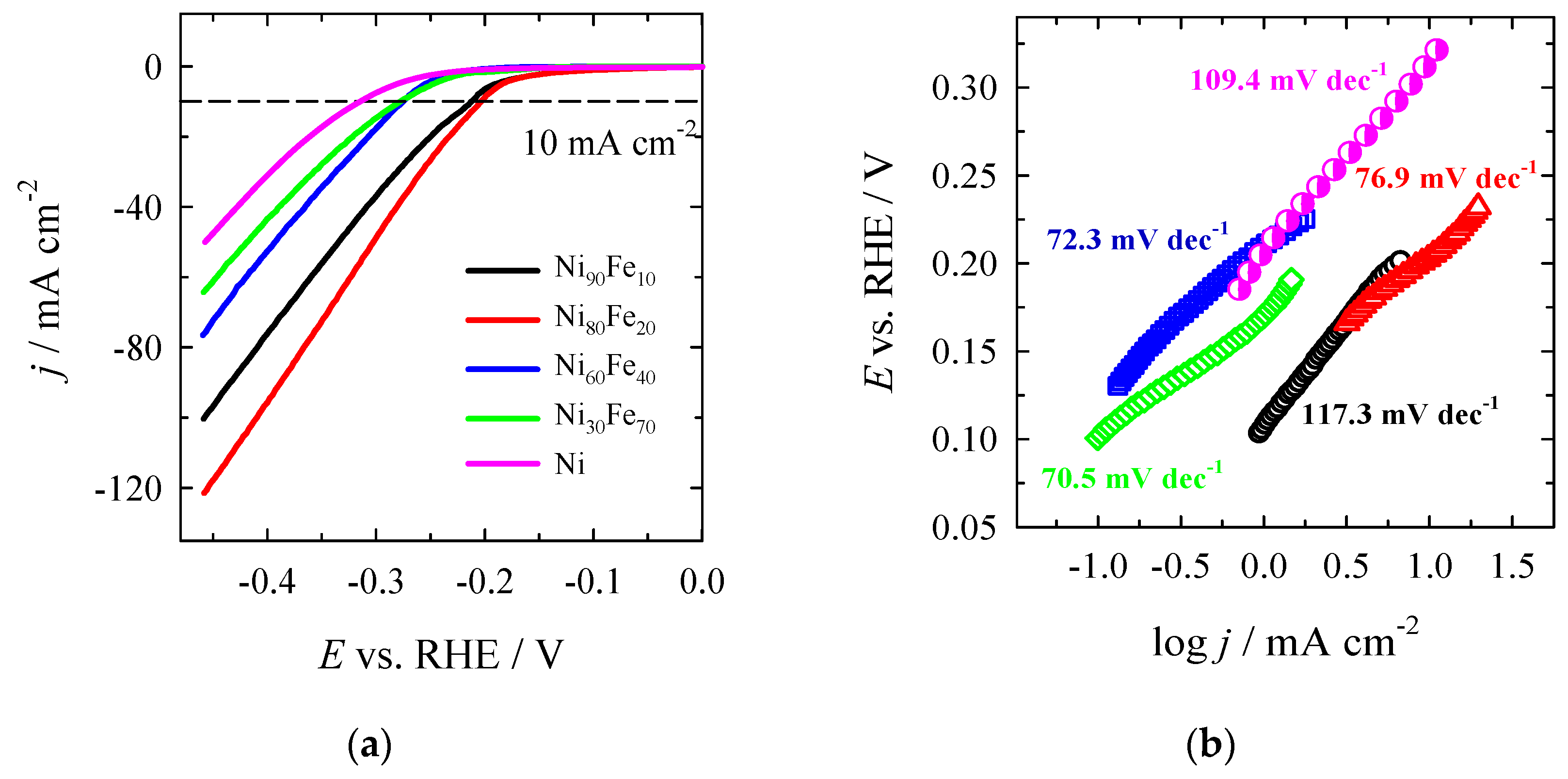
Figure 5.
(a) OER polarization curves of Ni, Ni90Fe10, Ni80Fe20, Ni60Fe40, and Ni30Fe70 catalysts in N2-saturated 1 M KOH solution at a potential scan rate of 2 mV s−1; (b) The corresponding Tafel slopes for each catalyst.
Figure 5.
(a) OER polarization curves of Ni, Ni90Fe10, Ni80Fe20, Ni60Fe40, and Ni30Fe70 catalysts in N2-saturated 1 M KOH solution at a potential scan rate of 2 mV s−1; (b) The corresponding Tafel slopes for each catalyst.
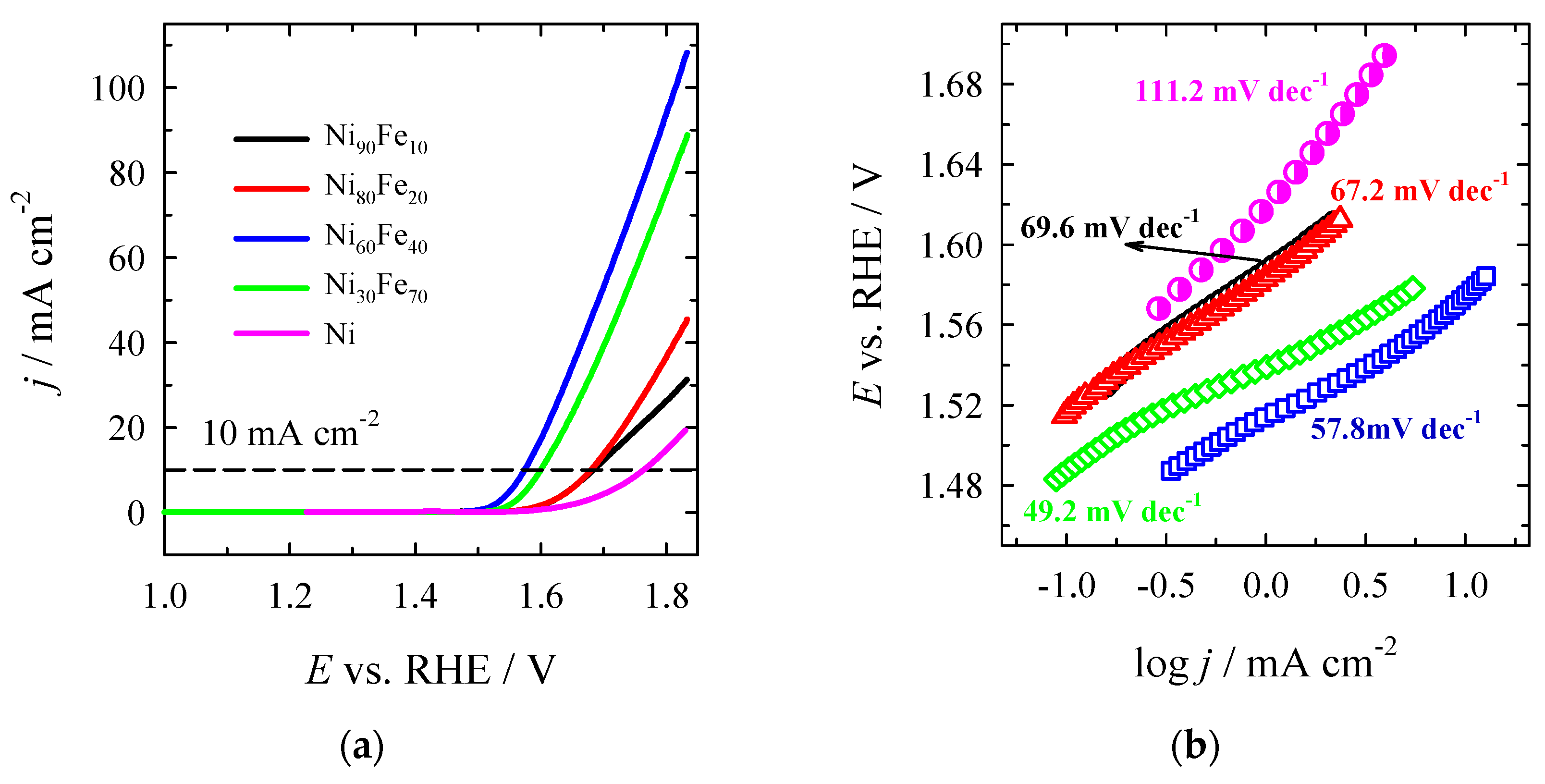
Figure 6.
(a) Predicted bifunctional activity of NixFey catalysts: values of full-cell potential Δη10 calculated from the difference between overpotential values (η10) at ±10 mA cm−2 obtained from the corresponding HER and OER LSVs in Figures 4a and 5a. (b) LSV curve for Ni60Fe40/Cu/PI as both anode and cathode electrocatalytic water splitting in 1 M KOH solution.
Figure 6.
(a) Predicted bifunctional activity of NixFey catalysts: values of full-cell potential Δη10 calculated from the difference between overpotential values (η10) at ±10 mA cm−2 obtained from the corresponding HER and OER LSVs in Figures 4a and 5a. (b) LSV curve for Ni60Fe40/Cu/PI as both anode and cathode electrocatalytic water splitting in 1 M KOH solution.
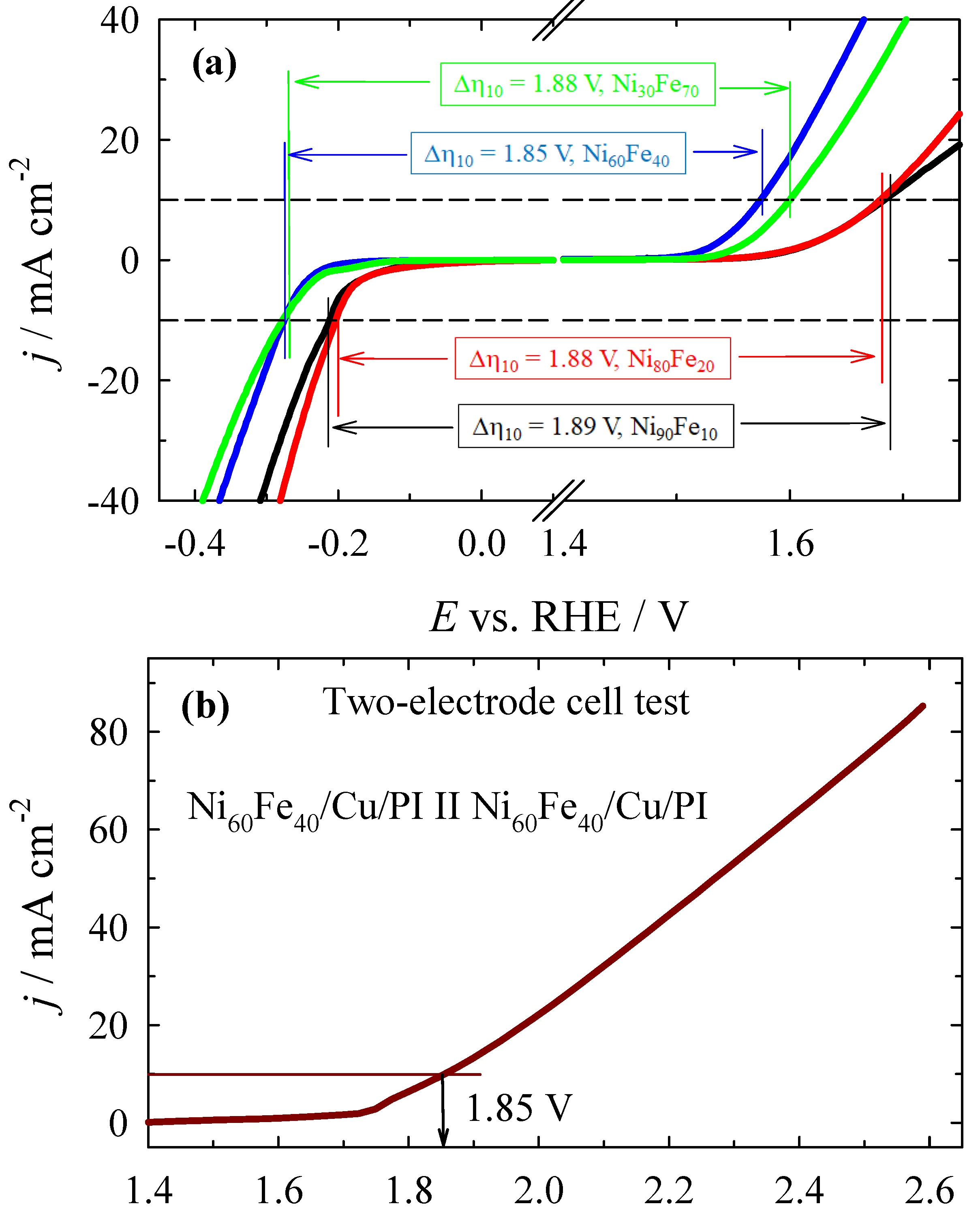
Figure 6.
The scheme of the plating process of NiFe on Cu/PI.

Table 1.
Composition of the deposited NixFey coatings determined by ICP-OES analysis.
| Sample | Metal loading in the coatings, mg cm−2 |
Element, at. % | Coating denoted as | |||
|---|---|---|---|---|---|---|
| Ni | Fe | Ni+Fe | Ni | Fe | ||
| No. 1 | 0.4805 | 0.9060 | 1.3865 | 34.60 | 65.30 | Ni30Fe70 |
| No. 2 | 0.6305 | 0.4521 | 1.0826 | 58.24 | 41.76 | Ni60Fe40 |
| No. 3 | 2.9040 | 0.6995 | 3.6035 | 80.60 | 19.40 | Ni80Fe20 |
| No. 4 | 2.3400 | 0.2695 | 2.6095 | 89.70 | 10.30 | Ni90Fe10 |
Table 2.
Electrochemical performance of Ni and the deposited NixFey coatings for HER in alkaline media.
Table 2.
Electrochemical performance of Ni and the deposited NixFey coatings for HER in alkaline media.
| Sample |
Eonset, V at j = −1 mA cm−2 |
η10*, mV | Tafel slope, mV dec−1 |
|---|---|---|---|
| Ni | −0.1722 | −303.4 | 109.4 |
| Ni90Fe10 | −0.1081 | −211.9 | 117.3 |
| Ni80Fe20 | −0.0928 | −202.7 | 76.9 |
| Ni60Fe40 | −0.2113 | −276.3 | 72.3 |
| Ni30Fe70 | −0.1710 | −278.4 | 70.5 |
* Overpotential at 10 mA cm−2.
Table 3.
Electrochemical performance of Ni and the deposited NixFey coatings for OER in alkaline media.
Table 3.
Electrochemical performance of Ni and the deposited NixFey coatings for OER in alkaline media.
| Sample | Eonset, V at j = 1 mA cm−2 | ηonset, mV | E, V at j = 10 mA cm−2 | η10*, mV | Tafel slope, mV dec−1 |
| Ni | 1.6163 | 386.3 | 1.7621 | 532.1 | 111.2 |
| Ni90Fe10 | 1.5868 | 356.8 | 1.6842 | 454.2 | 69.6 |
| Ni80Fe20 | 1.5829 | 352.9 | 1.6802 | 450.2 | 67.2 |
| Ni60Fe40 | 1.5162 | 286.2 | 1.5747 | 344.7 | 57.8 |
| Ni30Fe70 | 1.5390 | 309.0 | 1.5999 | 369.9 | 49.2 |
* Overpotential at 10 mA cm−2.
Table 4.
Composition of the electroless plating solution and plating parameters of NiFe coatings on Cu/PI surface.
Table 4.
Composition of the electroless plating solution and plating parameters of NiFe coatings on Cu/PI surface.
| Sample | Composition of plating solution, M | Plating conditions | |||||||
| NiSO4 | MB | NH2CH2COOH | FeSO4 | EDTA | CH2(COONa)2 | pH | T, oC | t, min | |
| No. 1 | 0.14 | 0.2 | 0.2 | 0.01 | 0.05 | 0.1 | 7 | 60 | 60 |
| No. 2 | 0.005 | ||||||||
| No. 3 | 0.001 | ||||||||
| No.4 | 0.0005 | ||||||||
Disclaimer/Publisher’s Note: The statements, opinions and data contained in all publications are solely those of the individual author(s) and contributor(s) and not of MDPI and/or the editor(s). MDPI and/or the editor(s) disclaim responsibility for any injury to people or property resulting from any ideas, methods, instructions or products referred to in the content. |
© 2024 by the authors. Licensee MDPI, Basel, Switzerland. This article is an open access article distributed under the terms and conditions of the Creative Commons Attribution (CC BY) license (http://creativecommons.org/licenses/by/4.0/).
Copyright: This open access article is published under a Creative Commons CC BY 4.0 license, which permit the free download, distribution, and reuse, provided that the author and preprint are cited in any reuse.
MDPI Initiatives
Important Links
© 2024 MDPI (Basel, Switzerland) unless otherwise stated


